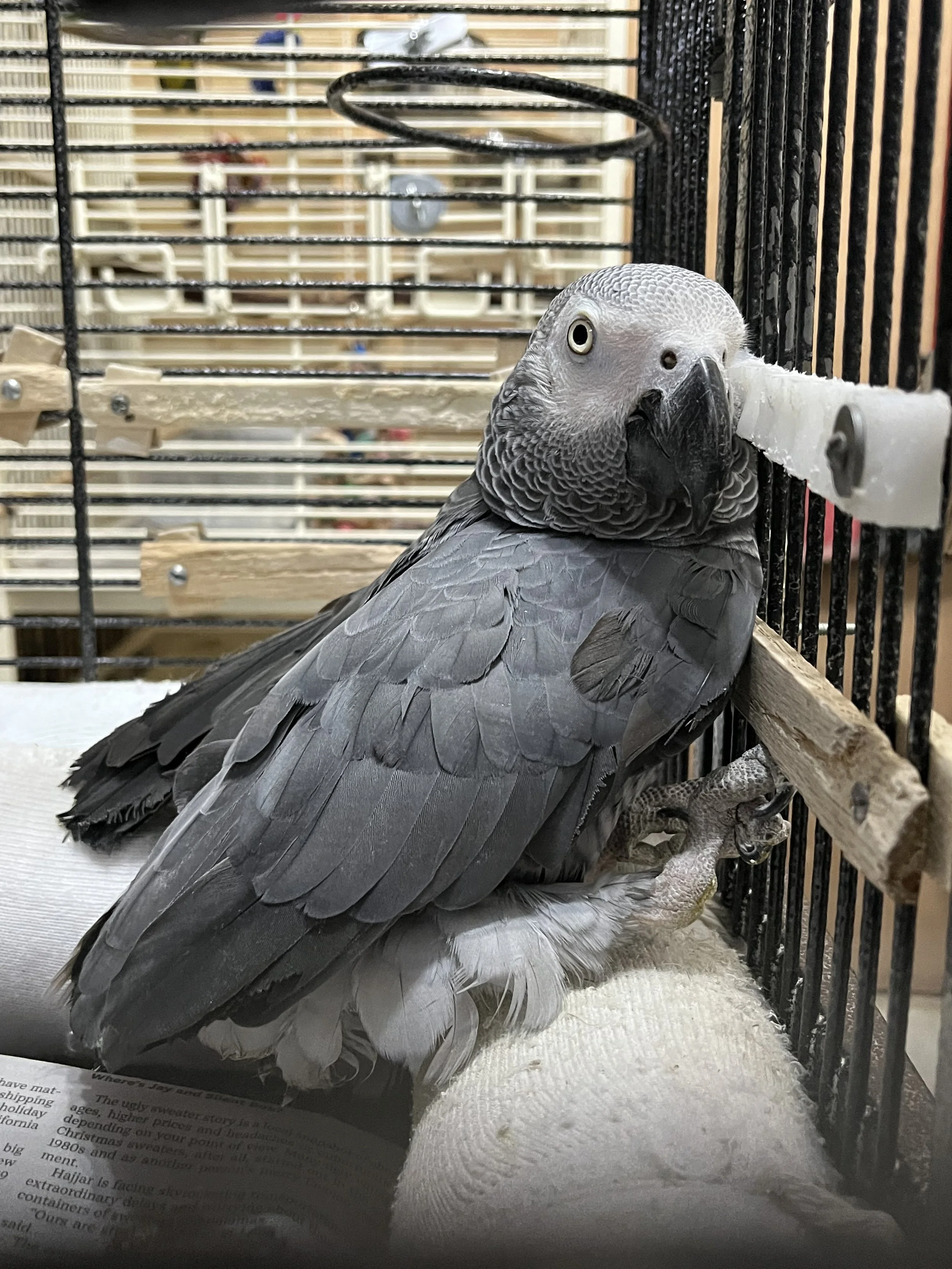
There are a lot of things to consider about parrots before adopting or purchasing. Medical is just one aspect, but often severely overlooked. Here you will find information about common diseases, testing, a list of avian vets in the Midwest, as well as some of our past unique medical cases.
As much as we would like to test for everything under the sun, financially and reasonably it is not feasible. Many rescues and breeders only test for the “big ones”, if they test at all. Those might include PBFD, Pacheco’s, or ABV. At Iowa Parrot Rescue we test birds with feather destructive behavior or from questionable backgrounds for PBFD on a case by case basis. We are very cognizant of the diseases present in our region throughout aviaries and rescues, and test as needed. Birds who show GI and neurological symptoms are tested for ABV.
If we tested every single bird, it would not only be a massive financial strain (meaning less money for more common issues like liver and heart disease), but a third of the birds would likely test positive for ABV. This is a fact that every rescue, breeder, and aviary deals with ABV due to the transmission method and little research that has been done on it. We cannot control the transmission any more than we can control Chicken Pox. Unnecessary testing can cause serious strain on an already stressed bird in a new environment. ABV is not something to fear as it was when first discovered in parrots in 2008. With proper knowledge, we believe every bird here has the potential to live an exceptionally happy life in a home for the full capacity of years they have.
All this said, we are more than happy to test any bird for any disease available through Animal Genetics at the adopter’s expense, beyond intake testing and labwork. All of our birds receive a complete panel of bloodwork to include chemistry and bile acids, medication as needed, supplements as needed (older, arthritic, weak immune system), x-rays as needed, and species appropriate diets.
Our goal is to not only find these parrots new homes, but to actually improve their health and enrich their lives before they go. One of the ways we do this is through nutrition. While disease testing IS massively important, it is performed on a case-by-case basis, which may not include the bird you intend to adopt. We cannot guarantee every bird will be free from all illnesses beyond the scope of testing that we have the capability of performing. If you are planning to adopt and want additional disease testing before you bring your bird home, expect to pay for additional tests (often $25 each) and a wait of 2 weeks for results. For more information on the most common diseases, read above.
Common Diseases
Some of the most common diseases for parrots are unknown to most bird owners. Those are things like the conditions listed to the right, and many more. These diseases range in severity from mild and treatable to severe and/or fatal. There are currently no vaccinations for these diseases, with the exception of Avian Polyoma Virus. These are problems that all bird owners should educate themselves on prior to bringing a bird home. It is important to note that while this all sounds very scary, we have seen few (if any) cases of these illnesses in 27 years of rescuing parrots. Knowledge is key and getting birds from reputable sources is the best way to ensure your birds’ safety.
-
Psittacine beak and feather disease (PBFD) is also known as Psittacine Circovirus (PCV). It is the most common and highly infectious viral disease among parrots. Parrots known to be particularly susceptible by PBFD include, but are not limited to, Cockatoos, Ringneck Parakeets, Macaws, African Grey Parrots, Eclectus Parrots, and Lovebirds. What makes this disease so destructive is the ability to remain in the environment for over 18 months, if not destroyed. Transmission of the virus from one individual to another is primarily through direct contact, crop-feeding, infected fecal material, and/or feather dust. The virus can also be transmitted via contaminated surfaces such as bird carriers, feeding formula, utensils, food dishes, clothing, and nesting materials.
Symptoms include irreversible loss of feathers, shedding of developing feathers, development of abnormal feathers, new pinched feathers, and loss of powder down. Other possible symptoms include overgrown or abnormal beak, as well as symmetrical lesions on the beak and occasionally nails. Immunosuppression, rapid weight loss, and depression are also possible.
This is a highly contagious disease and any bird exhibiting an abnormal loss of feathers, changes in feather development, or feather destructive behavior should be tested for it. Testing is fairly easy and can be done via blood or feather at the vet or using Avian Biotech. Blood is the most accurate way of testing, as not all feathers will be affected or show the virus on testing. This disease mostly affects young birds with underdeveloped immune systems (notably hatchlings), but can occur in adult birds. Many adult birds will be able to shed the virus but will remain carriers for life and may have "flare ups" of their symptoms in times of stress. Do note that not all infected birds will show symptoms and all birds in a flock should be tested and quarantined if PBFD is present. It is recommended to re-test all PBFD positive birds 60-90 days after the first test is performed. If the second sample remains positive, the bird should be considered permanently infected and can be expected to show clinical symptoms of the disease. While it is the most common disease, it's still not actually all that present in most normal pet bird homes. Bird fairs and pet stores are the riskiest places to be due to the strong likelihood of baby birds contracting it from parents.
-
Avian Bornavirus is a relatively new virus, first discovered in 2008 in parrots. Avian Bornaviral Ganglioneuritis (ABG) is an immune-mediated disease and is responsible for what has been previously known as Proventricular Dilatation Disease (PDD) or Macaw Wasting Disease.
As many as one-third of the entire avian population in captivity and in the wild test positive for the Avian Bornavirus (ABV) according to MANY studies. Avian Bornavirus has been proven to be a cause of Avian Bornaviral Ganglioneuritis and has been detected in birds around the world. ABV affects every part of the body but most notably the central nervous system. The species most susceptible are Macaws, Cockatoos, Amazons, Eclectus, and African Greys. Conures, Quakers, Lovebirds, Pionus, and Budgerigars have been minimally represented. It is worth noting that waterfowl are also very susceptible to the same virus.
ABV is transmitted by fecal, oral, and nasal routes through saliva, crop feeding, and aerosolized infected fecal matter. It is thought that birds must come in close contact with the saliva and fecal matter of an ABV-positive bird to become infected, such as in bonded pairs. The virus only lives a number of hours outside the host, so it does not readily pass from bird-to-bird. The most common route of transmission is mother-to-chick (vertical transmission) through the egg membrane, meaning many parrots are actually born with the virus in their systems. Every bird infected with ABV will never be rid of the virus and will remain a carrier for life, "flaring up" during times of stress such as reproductive periods (when nesting or overly hormonal), crowded shelter environments, pet stores, and travel.
You should not automatically assume a bird is afflicted with Avian Bornaviral Ganglioneuritis simply because it tests positive for ABV. It might take years before an ABV-positive bird develops signs of ABG, and some never become symptomatic. It is not known if or when the bird will become symptomatic or what will trigger the onset of disease, since it is still being newly researched. Even single pet birds housed in the same environment for many years have been diagnosed with the disease. Avian Bornavirus primarily affects the CNS and nerves of the gastrointestinal tract. Birds may exhibit only one or the other, but some experience both. The virus usually affects both, even if they are not initially obvious.
Avian Bornaviral Ganglioneuritis GI symptoms include depression, weight loss and abdominal enlargement, muscular atrophy, crop stasis and regurgitation, excessive urination, weakness and loss of body condition (emaciation), undigested food in the feces, Poor absorption and impaired GI tract transit, and excessive eating. Neurological CNS symptoms may include lack of coordination/difficulty balancing, body tremors/head tremors, seizures, paralysis, motor and proprioceptive deficits, aggressive behavior, feather plucking, and self-mutilation due to peripheral neuritis. Also seen are anorexia, reduced cognitive ability, vocalization abnormalities, and hypersensitivity to sensory pain or discomfort.
ABV is a simple virus that can lead to a VERY complex disease (ABG). It's worth noting that not every bird who contracts ABV will develop ABG, but every infected bird does have the potential. The most important things to know are keep your environment as stress-free as possible, clean supplies/cages/perches/toys with bleach before introducing to a new bird, quarantine new birds away from existing birds to evaluate for symptoms of ABG, keep the home well ventilated, and do not smoke around your bird as it suppresses the immune system and makes them more susceptible to developing severe illness.
Unfortunately, there is no definitive diagnosis of ABG except on necropsy. There are, however, some blood tests and scans that can give a strong indication of the disease. ABV can be tested for via blood through a vet or Animal Genetics, CT can be performed to evaluate and measure the proventriculus size, a crop biopsy can show lymphoplasmacytic ganglioneuritis in the crop tissue, which would provide a definitive answer. This does require infected ganglia to be present or it could show a false result. Due to how common the disease is in captivity and it's low transmission rates, one should do their due diligence in maintaining good hygiene and reduce stress to manage it. Testing can be performed for all new birds, but it is often unnecessary. Quarantine is important for all new birds regardless of background and yearly vet visits can assist in reducing their risk for severe disease. For more up to date information on this complex disease, an article has been attached for your reading.
-
This pathogen is considered one of the most significant threats to caged birds and waterfowl around the world. This highly-infectious disease affects most, if not all, parrot species. Eclectus, Caiques, Hawkheads, and Budgerigars seem to be the most common carriers/affected. Polyoma is the most problematic among neonates (young birds) between the ages 14-56 days. Young birds often die, while adult birds can develop a certain level of immunity. Polyoma is currently believed to have an incubation period of approximately two weeks or less, so any very hatchling birds and parents should be vaccinated for this disease. This is not a large concern in the general population in rescues across the US.
One of the things that makes it so dangerous is the contagion potential and there being no cure or treatment for the disease. It is generally considered fatal in most cases. The disease can spread from one bird to another via feather dust, feces, aerosols, and parental feeding of chicks. APV can also be transmitted via direct contact or contact with infected environments (incubators, nest boxes, etc.).
Symptoms are generally fairly non-specific, but severe. Symptoms may include swollen abdomen, depression, loss of appetite, anorexia, weight loss, delayed crop emptying, regurgitation, diarrhea, dehydration, feather abnormalities, shortness of breath, excess urination, ataxia, tremors, paralysis, and acute death.
You can test for Polyoma Virus at your vet's office by request or using online testing sites like Avian biotech or Washington State University. It's recommended to only purchase baby birds who have been vaccinated for APV. Most pet bird owners do not have to be concerned about this disease unless introducing very young birds.
-
As the name suggests, Pacheco's disease is the psittacine Herpes virus. It's caused by the same family of viruses but is often far more dangerous. Considered highly contagious, Pacheco's can spread rapidly through an aviary or rescue. Often the first sign the disease is present is when a new bird is introduced and healthy birds begin mysteriously dying. Pacheco's disease is often fatal and affects psittacines of all ages. New World parrots seem to be more susceptible to the disease than Old World parrots. Amazons are most susceptible, while Patagonian and Nanday Conures seem oddly resistant. Unlike Bornavirus, PDV remains remarkably stable outside the bird as dust or aerosol. This dust or aerosol contaminates the air, that is then inhaled by other birds. Contaminated surfaces, food, and drinking water may also contribute to the spread of the disease. This is a very similar transmission to PBFD.
Symptoms include lethargy, diarrhea, ruffled feathers, sinusitis, anorexia, conjunctivitis, and tremors in the neck, wings, and legs. It's also common for liver issues to arise, discoloring urates or causing severe liver necrosis.
Thankfully, Pacheco's isn't commonly seen post importation ban. It was very common prior to 1993 because many parrots were being imported en masse, thus spreading the disease throughout aviaries all over the United States. While not common, it can still occur so any new addition from unknown background should be quarantined separate from an established flock. Pacheco's can be tested for at a vet's or on Avian Biotech, but note it can be inconsistent due to the amount of antibody shedding.
-
The genus Aspergillus contains a multitude of fungi that cause the condition we know as Aspergillosis. This is not an avian specific illness, but due to their sensitive respiratory systems they seem particularly susceptible to it. Immune-compromised individuals may develop a more chronic form o fit, leading to recurrent sinus and respiratory infections. Aspergillus fungi are opportunistic and found all throughout our environments, especially in dry and dusty conditions. Many places will tell you NOT to feed peanuts in the shell to your parrot-this is the main reason for that. Since Aspergillus are typically found in the ground, it makes any underground-grown produce susceptible to harboring it. Human grade peanuts CAN be mold-tested and fungus-tested, but the risk is higher than any reward.
Aspergillosis is commonly treated with antifungals and most birds go on to recover, provided the initial reasoning for infection is treated. The spores are often present in the environment and healthy, unstressed birds are generally resistant to even high levels of spores. However, young and old birds, birds on antibiotics and those birds whose immune systems are suppressed by surgery, reproduction, environmental changes, or age are frequently infected.
Symptoms range from respiratory distress, gasping, accelerated breathing, voice changes, abnormal droppings, emaciation, regurgitation, poor appetite, diarrhea, anorexia, acute gout, increased thirst, nasal discharge, conjunctivitis, and lethargy. It can be tested for at the vet's, but do note that often the chronic form will not show up on a standard PCR test. X-rays of the thoracic cavity can prove very useful in diagnosis. Asper is likely the disease most commonly seen in pet birds. Prevention and understanding the signs/symptoms is the key to managing this condition.
Avian Vets Iowa, Illinois, South Dakota -
If you have a vet to contribute to our list, especially expanding into IL, MO, NE, MN, or ND, please send us an email outlining the vet clinic, the particular vet (if necessary), their location, and what services they can provide.
Dr. Spencer, Care Animal Center, Davenport IA- basic exams, bloodwork
WhiteHaven Clinic, Davenport IA- basic exams, maintenance
Dr Jana, Bright Eyes And Bushy Tails, Iowa City IA- emergency, all exams/scans/bloodwork, small birds reptiles accepted
Alinda Sabourin, Animal Kingdom, North Liberty IA-all exams/scans/bloodwork, potential pigeons accepted
Dr Jen, QCVC, Milan IL- everything (pigeons/doves accepted), minor surgeries
Niles Hospital and Bird Medical Center, Niles IL - all exams/scans/bloodwork
Dr Conrad, VCA Edgewood, Cedar Rapids IA- all exams/scans/bloodwork (pigeons/doves accepted)
BluePearl, Cedar Rapids IA- emergency only. Call to see if exotics are accepted before going.
Dr Lori, Den Herder, Waterloo IA- all exams/scans/bloodwork
Ankeny Avian Clinic, Ankeny IA- all exams/scans/bloodwork
Dr Melinda Austin, South Des Moines Veterinary Center, S Des Moines IA- all exams/scans/bloodwork
Animal Medical Center, Spencer IA- exams, maybe bloodwork?
Faithful Friends, Sioux Falls SD- exams, minor medical concerns, bloodwork. Small birds
Dr Marianne Kirkendall, Colonial Terrace, Dubuque IA- all exams/scans/bloodwork, emergency (see website for details)
Oaks Veterinary Clinic, Des Moines IA- all exams/scans/bloodwork (pigeons/doves accepted) reptiles accepted
Midland Prairie Veterinary Services, Maxwell IA - exams, reptiles + other exotics accepted
* EMERGENCY VETS * always call ahead of time
Animal Emergency Center of the Quad Cities (AEC) - (563) 344-9599
BluePearl, Cedar Rapids - 319.841.5161
Bright Eyes Bushy Tails, Iowa City - (319) 351-4256 or (319) 338-3605
BluePearl, Des Moines - 515.727.4872
Iowa Veterinary Specialties, Des Moines - 515-280-3051
Madison Veterinary Specialties, Madison WI - 608-274-7772
UW Wisconsin Veterinary Hospital, Madison WI - 608-263-7600 - has surgery and advanced scans
Midwest Bird and Exotics Hospital, Elmwood Park IL - 708-453-4755
Chicago Exotics Animal Hospital, Skokee IL - 847-673-9110
U of Il Urbana-Champaign Zoo Med, Urbana IL - 217-333-5300 - has surgery and advanced scans
Medical Cases
Often we have intakes with beak deformities or excess growth and flaking. There are many reasons for this to occur, from diet and age, lifestyle, to skeletal/congenital deformities such as scissor beak, even diseases like PBFD. Things like congenital malformations can actually alter the way the bones form and make eating and chewing difficult. We aim to fix these issues quickly so the bird can go back to living life normally. We do offer nail and beak trimming services for boarding birds, but not to the general public to reduce the chances of disease transmission.
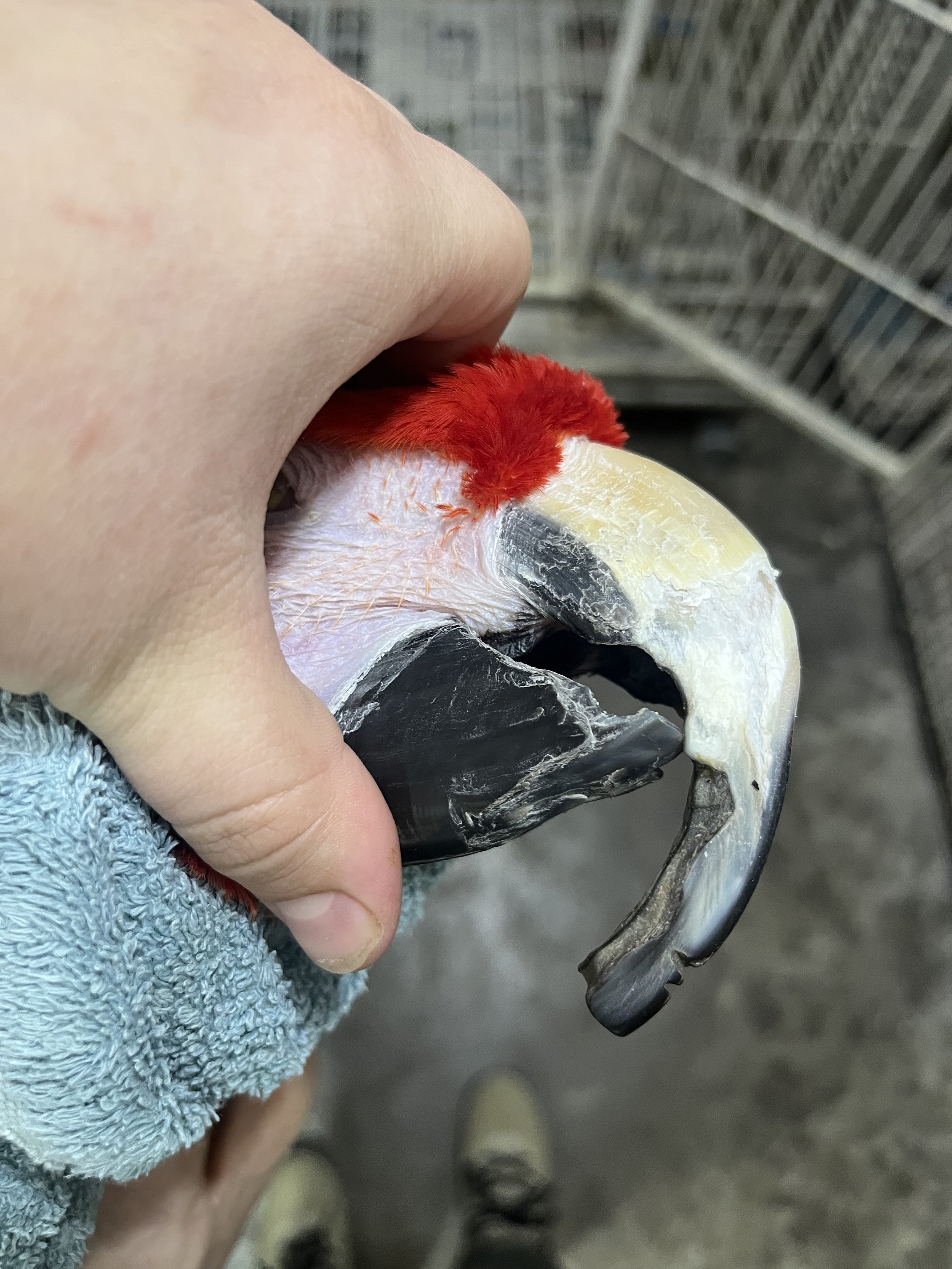
50+ year old Scarlet Macaw
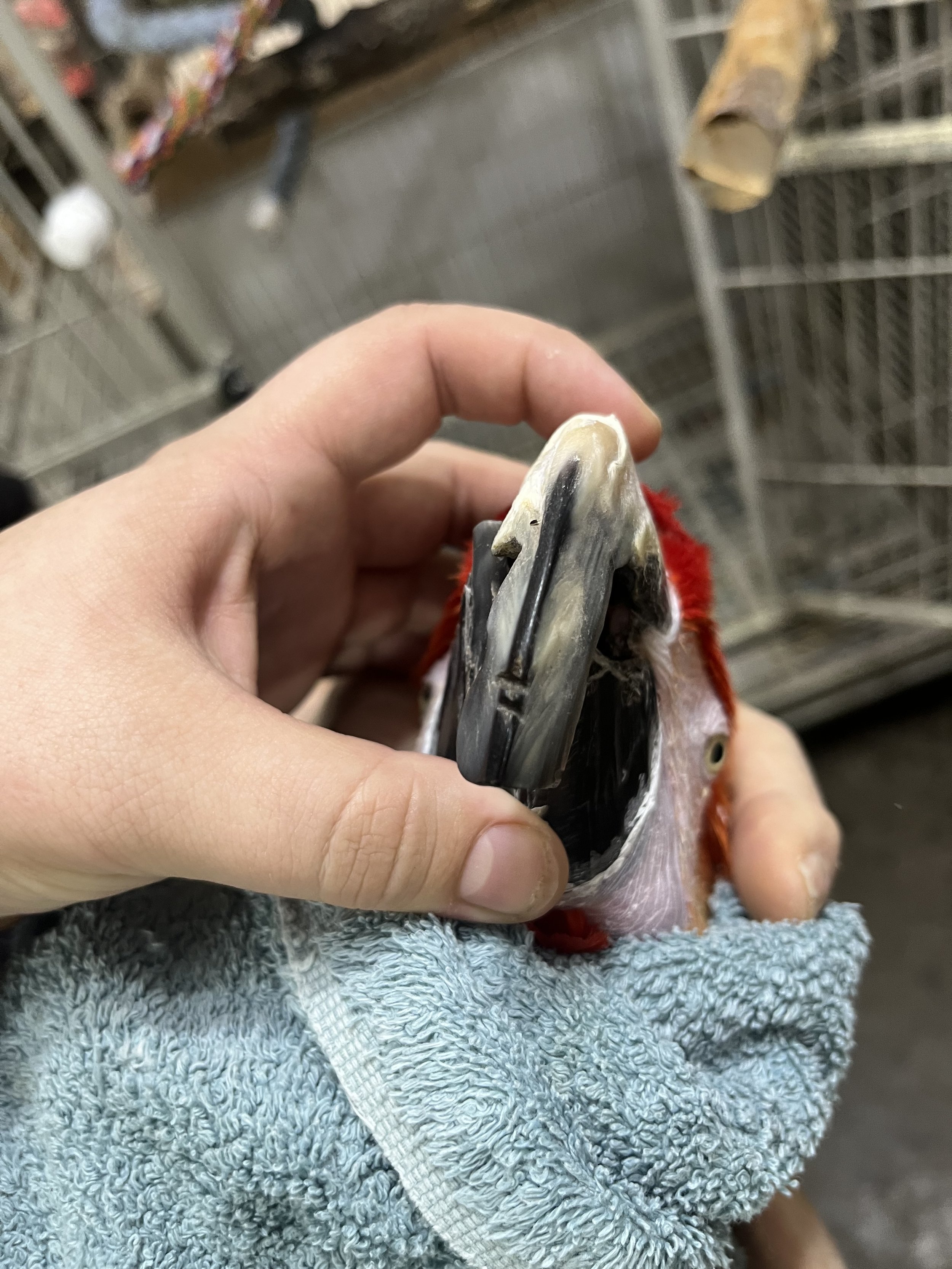
Severe scissor beak deformity and overgrowth
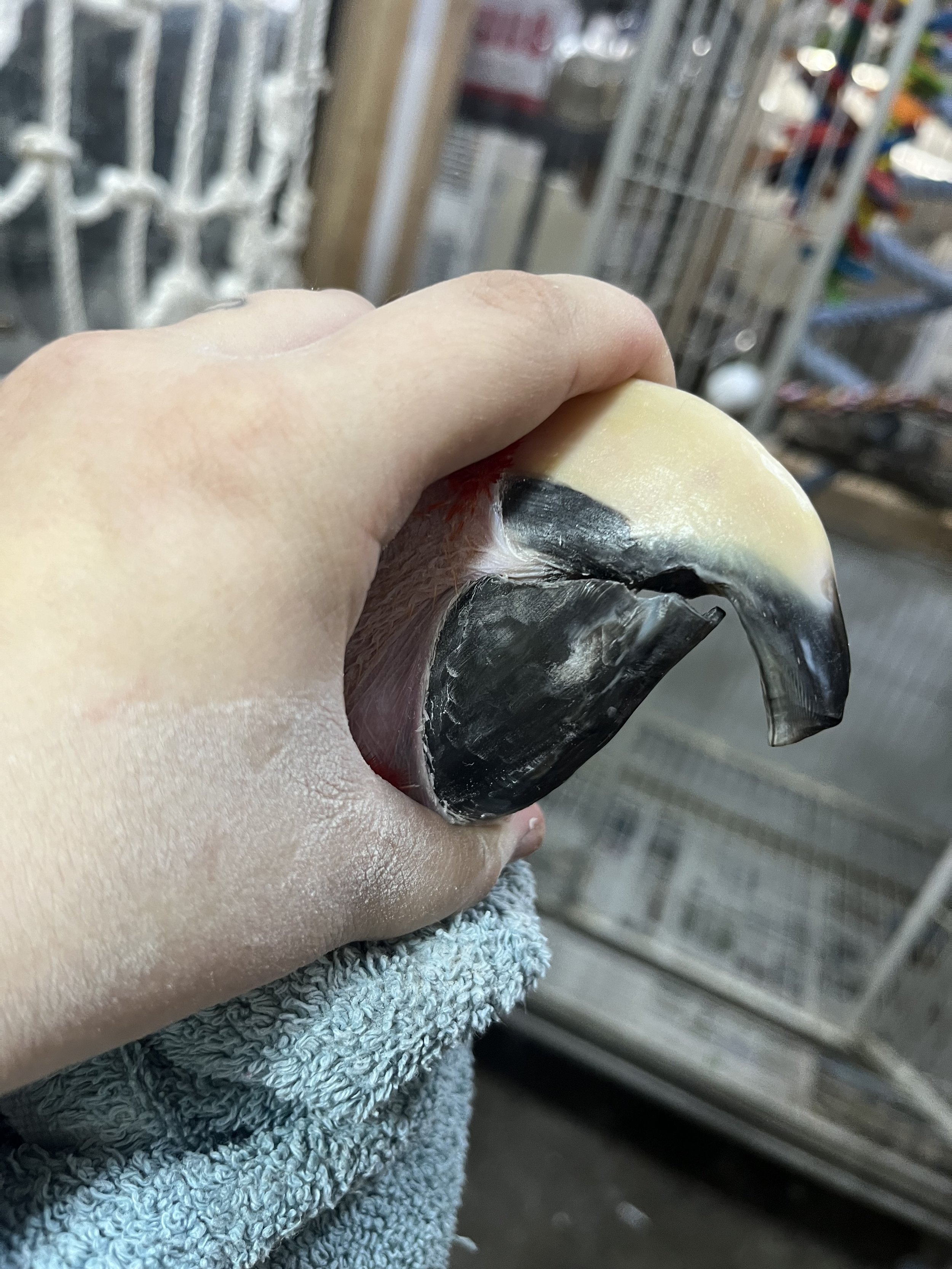
Rough Trim
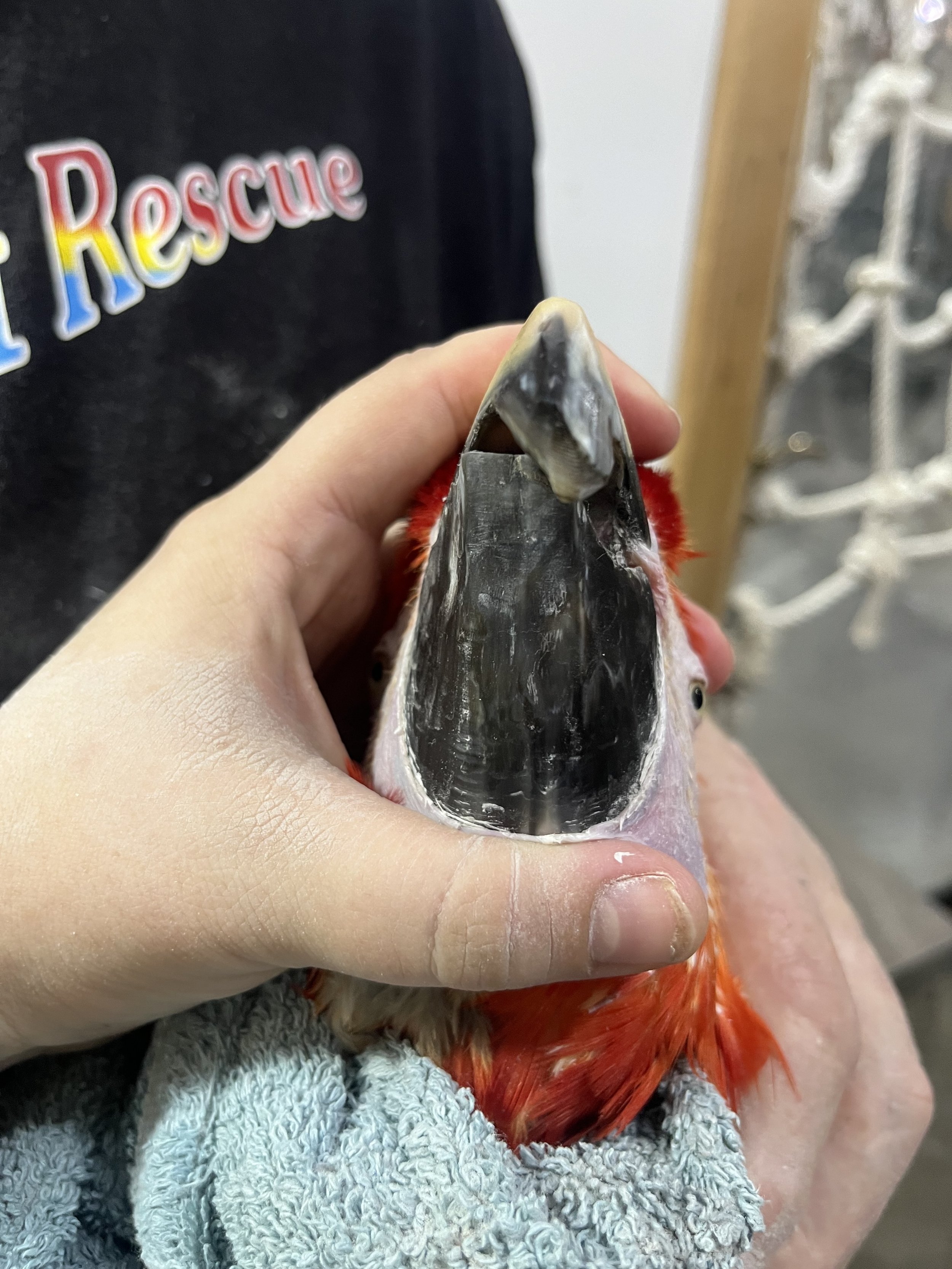
The lower beak is at risk of splitting due to being brittle and overgrown. More work is needed on this beak.
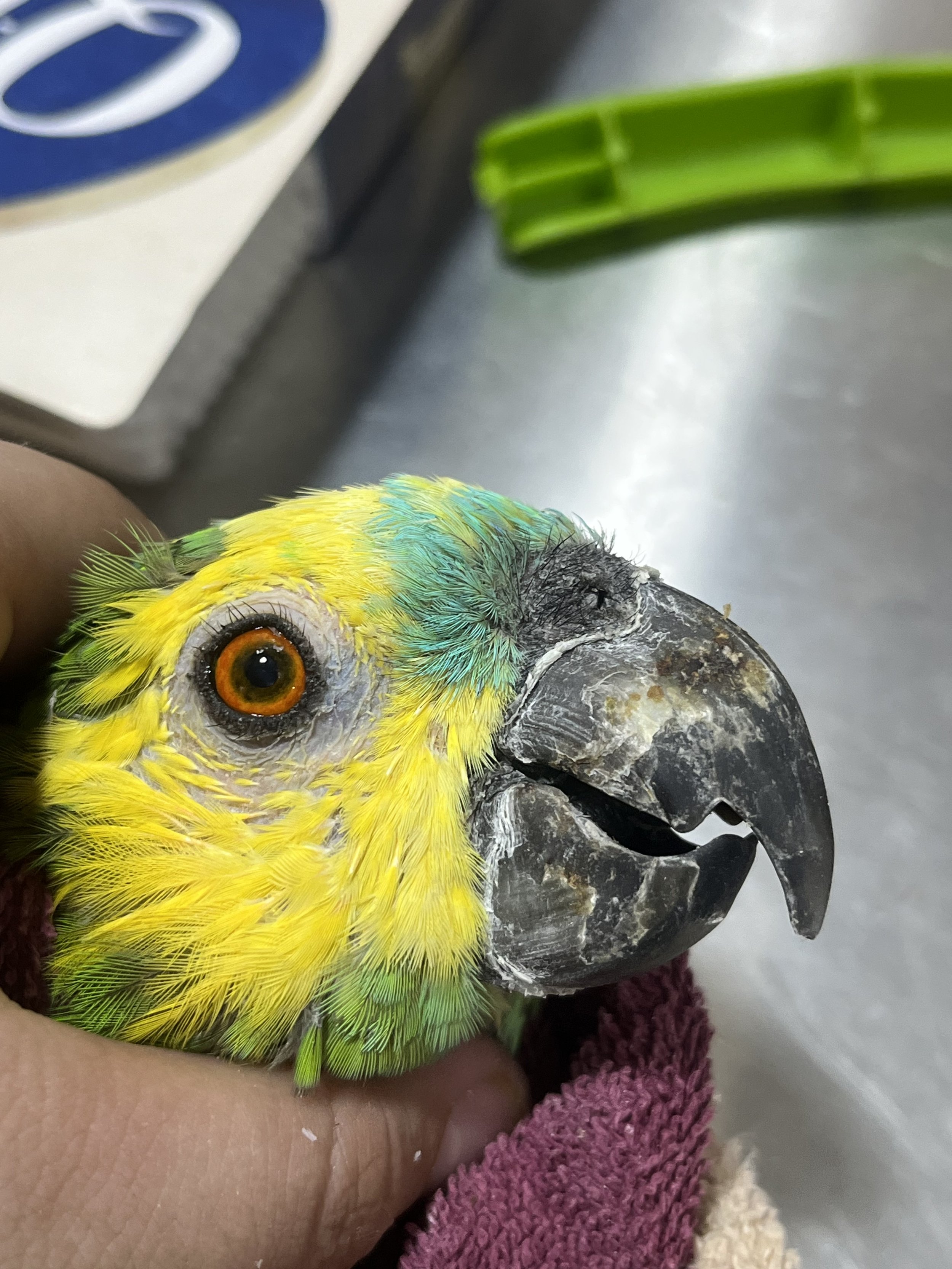
Unknown age Blue-Front Amazon
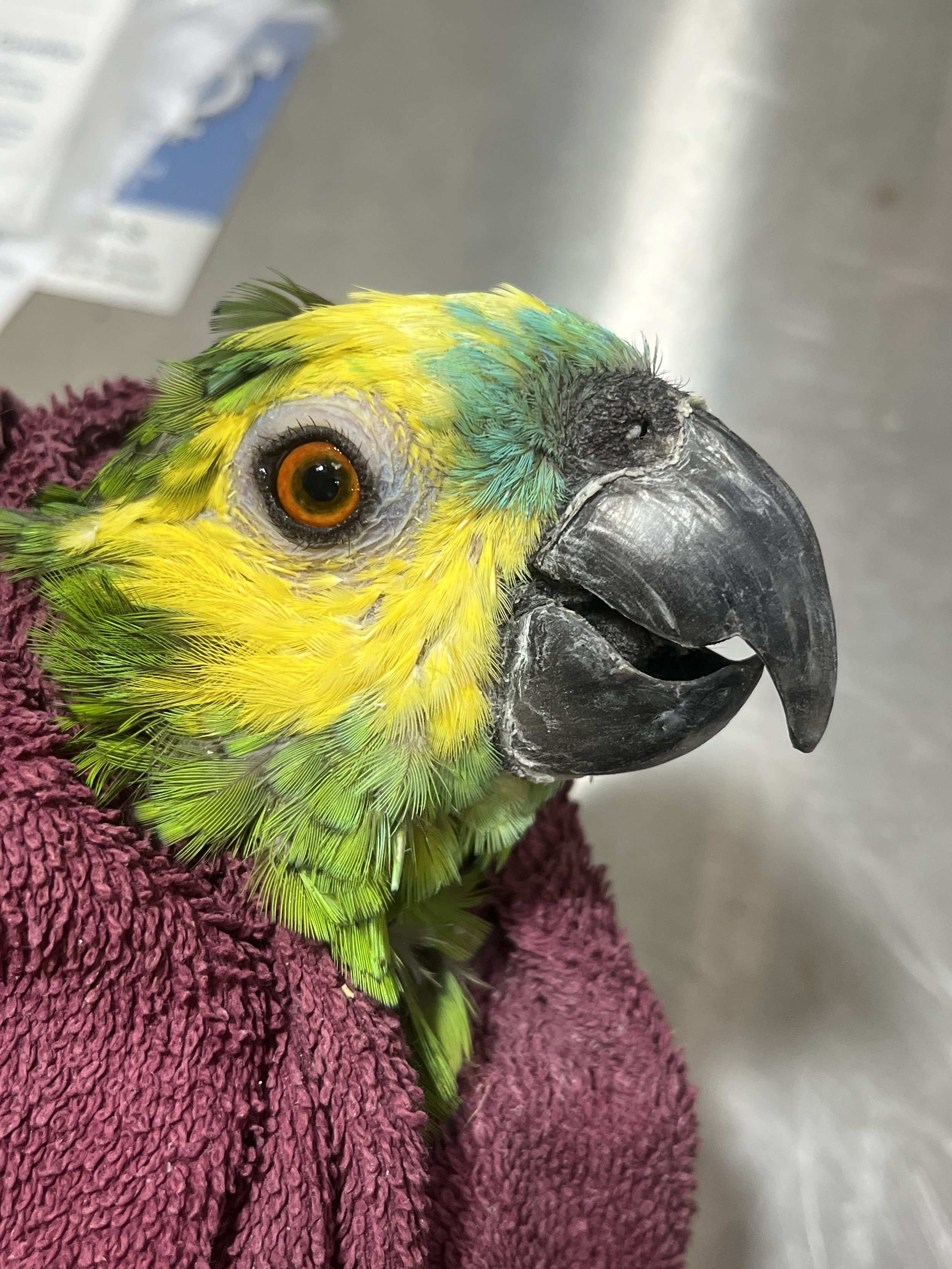
Removed flaking from surface of beak
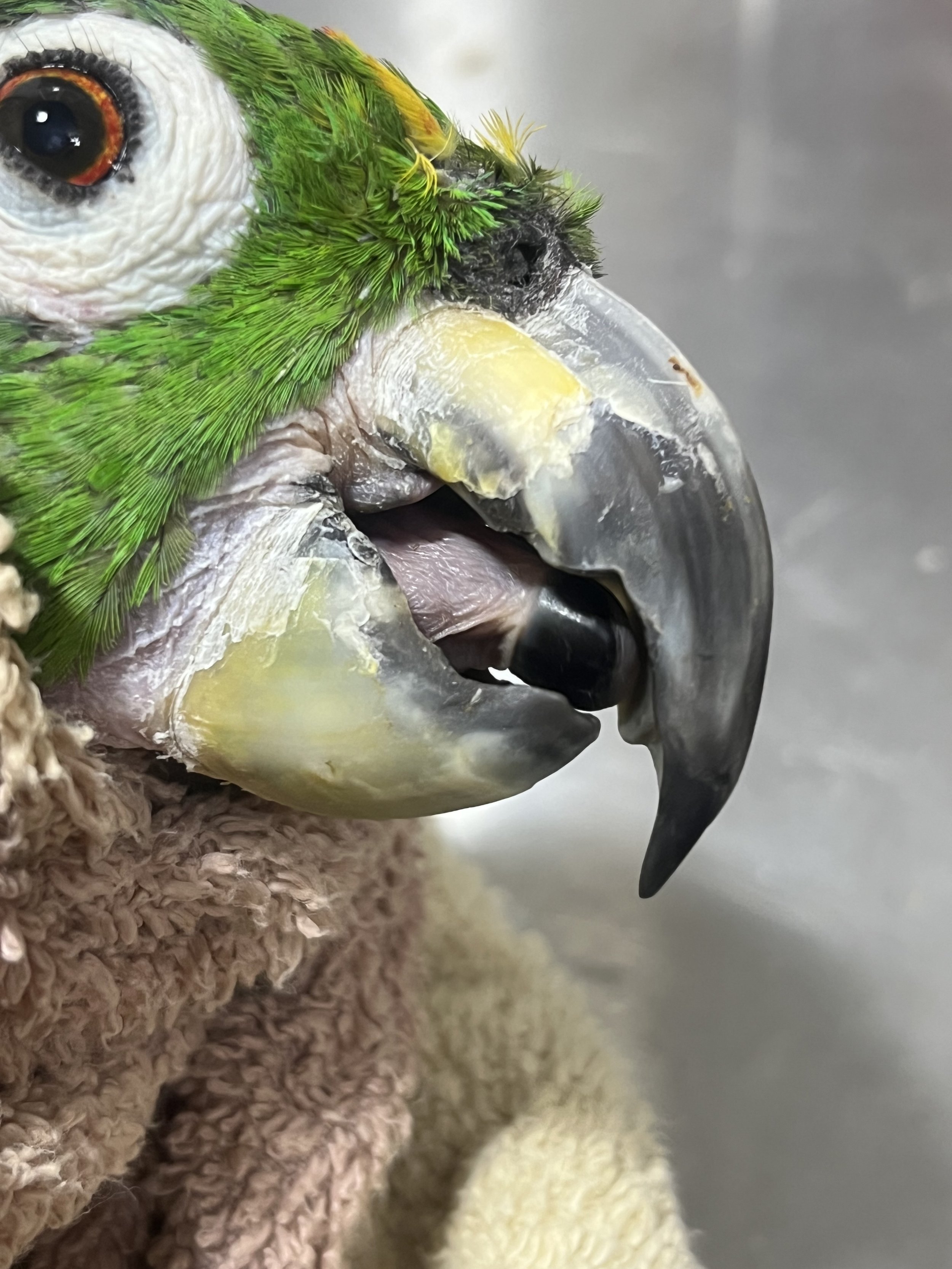
Unknown age Mealy Amazon, flaking and unilateral overgrowth present on upper mandible.
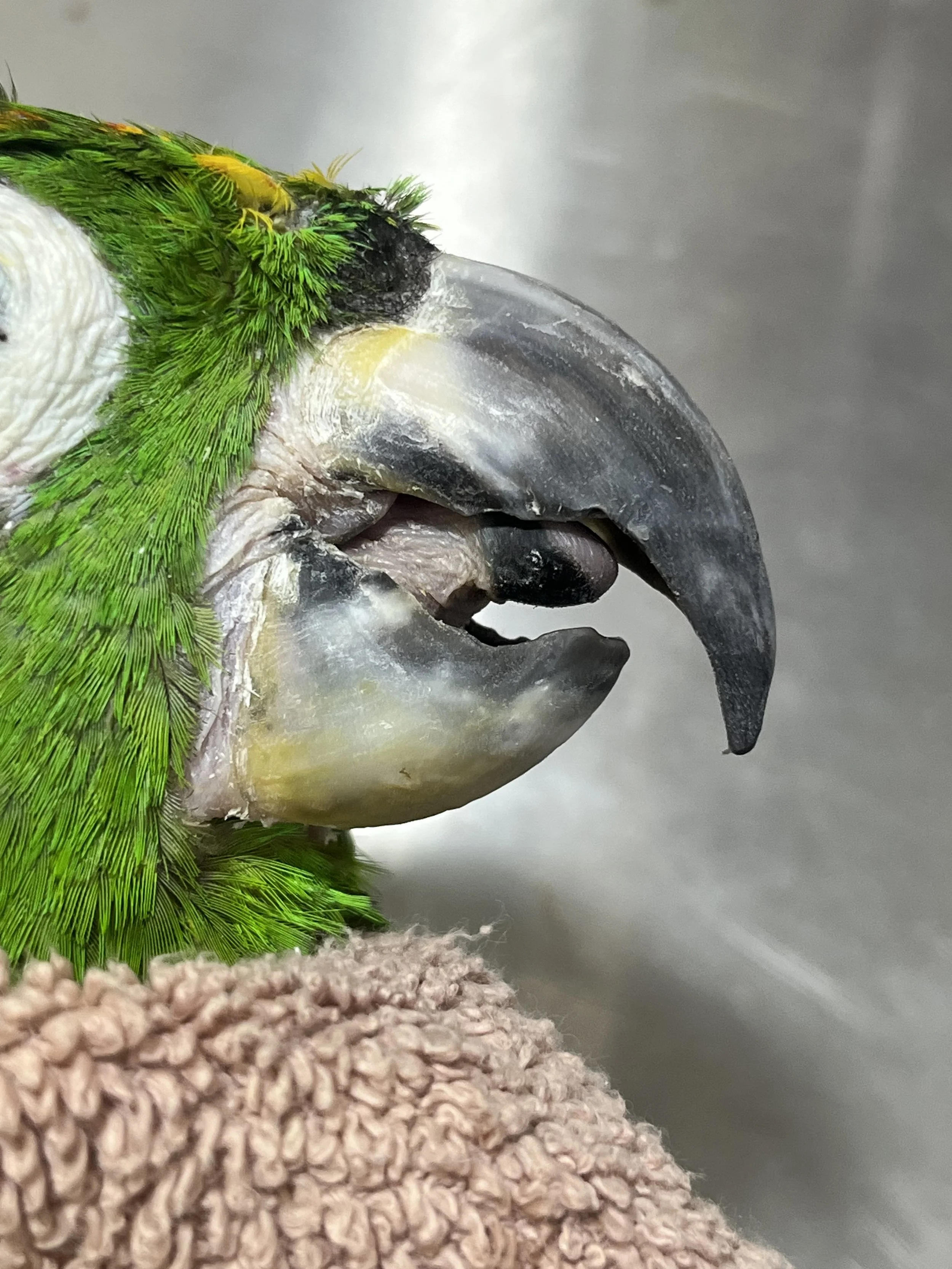
Removed overgrown flaking and reshaped upper mandible to prevent improper wear
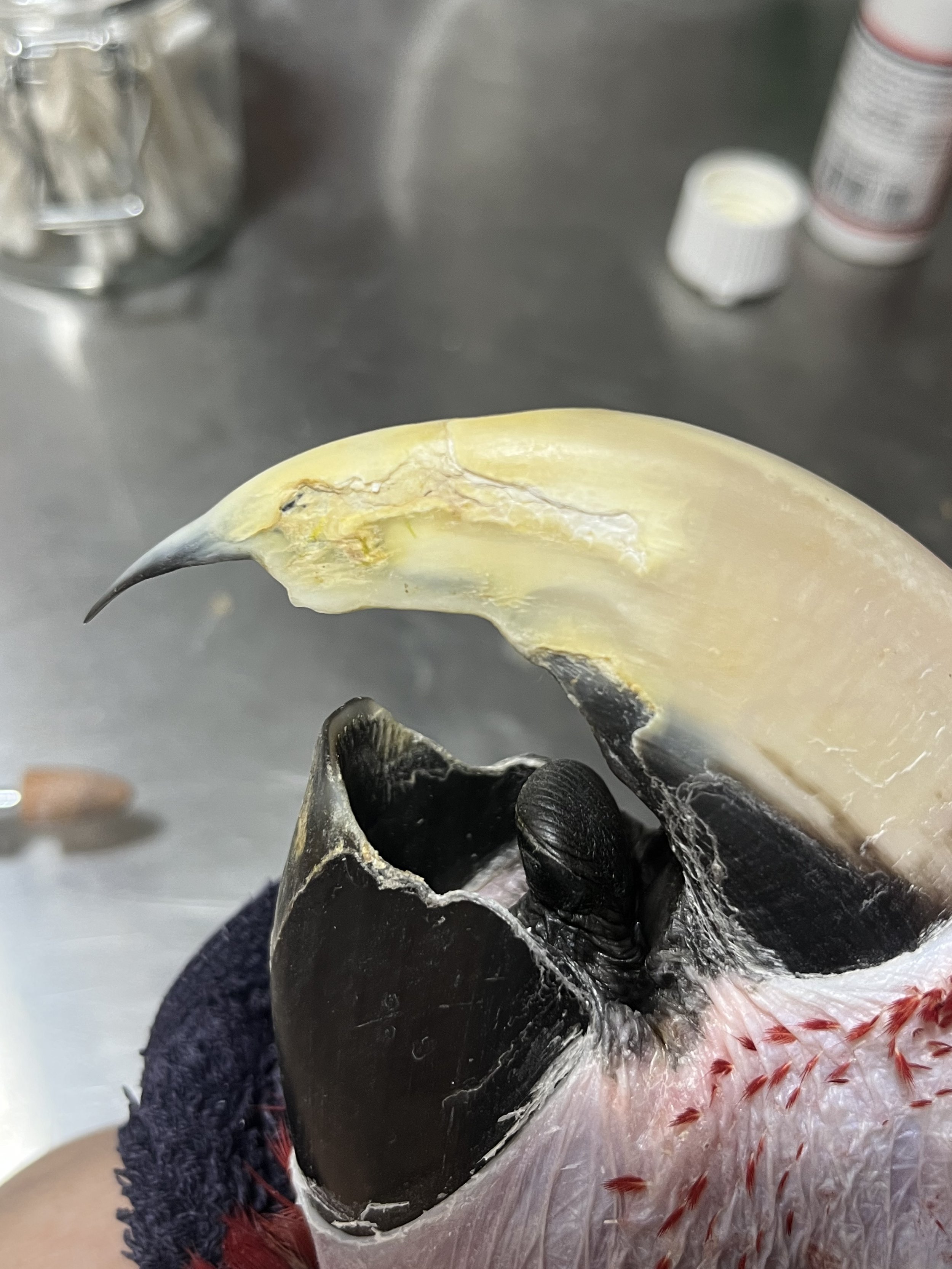
45 year old Greenwing Macaw
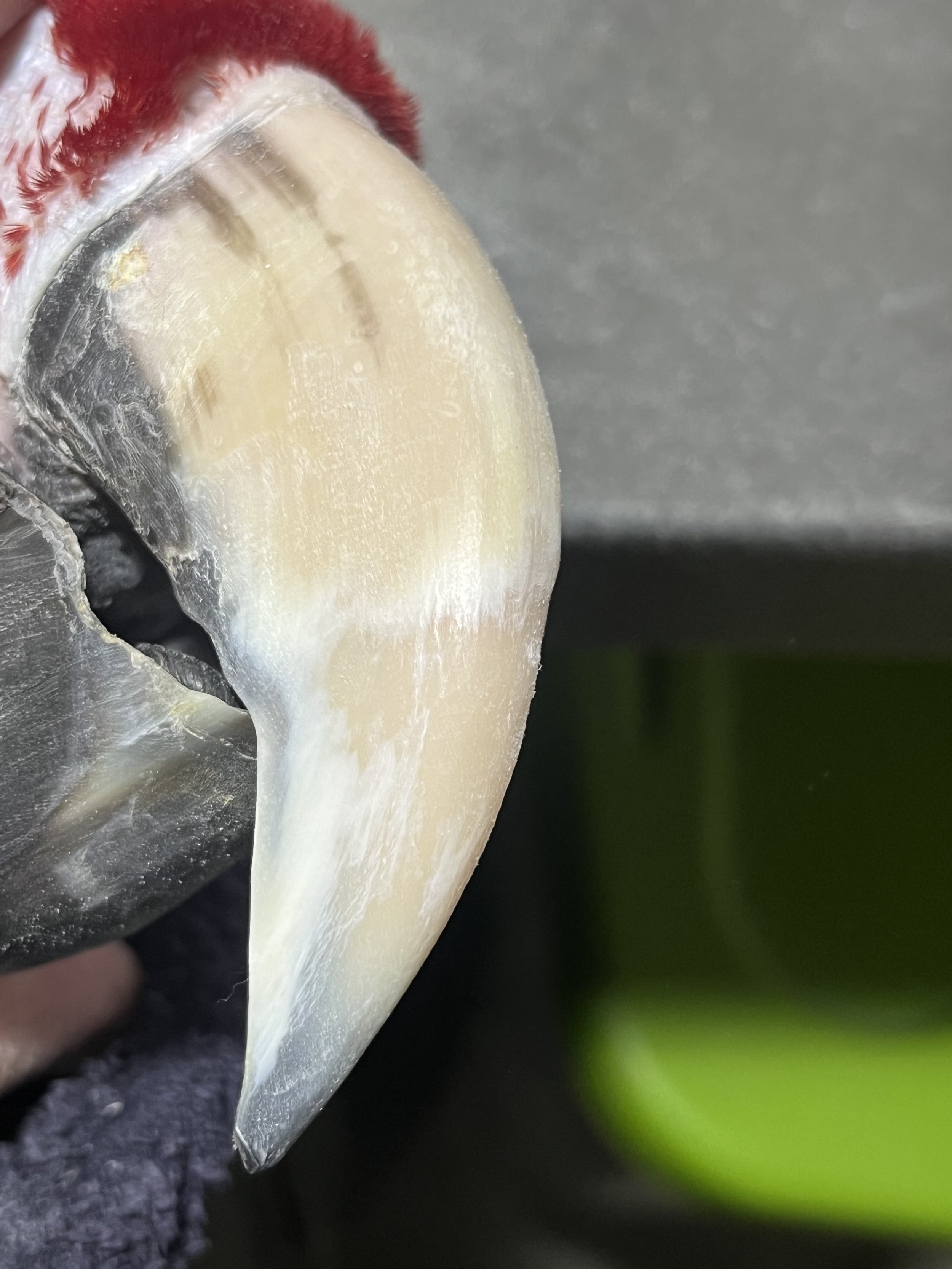
Removed flaking, chips, shortened and shaped the tip.
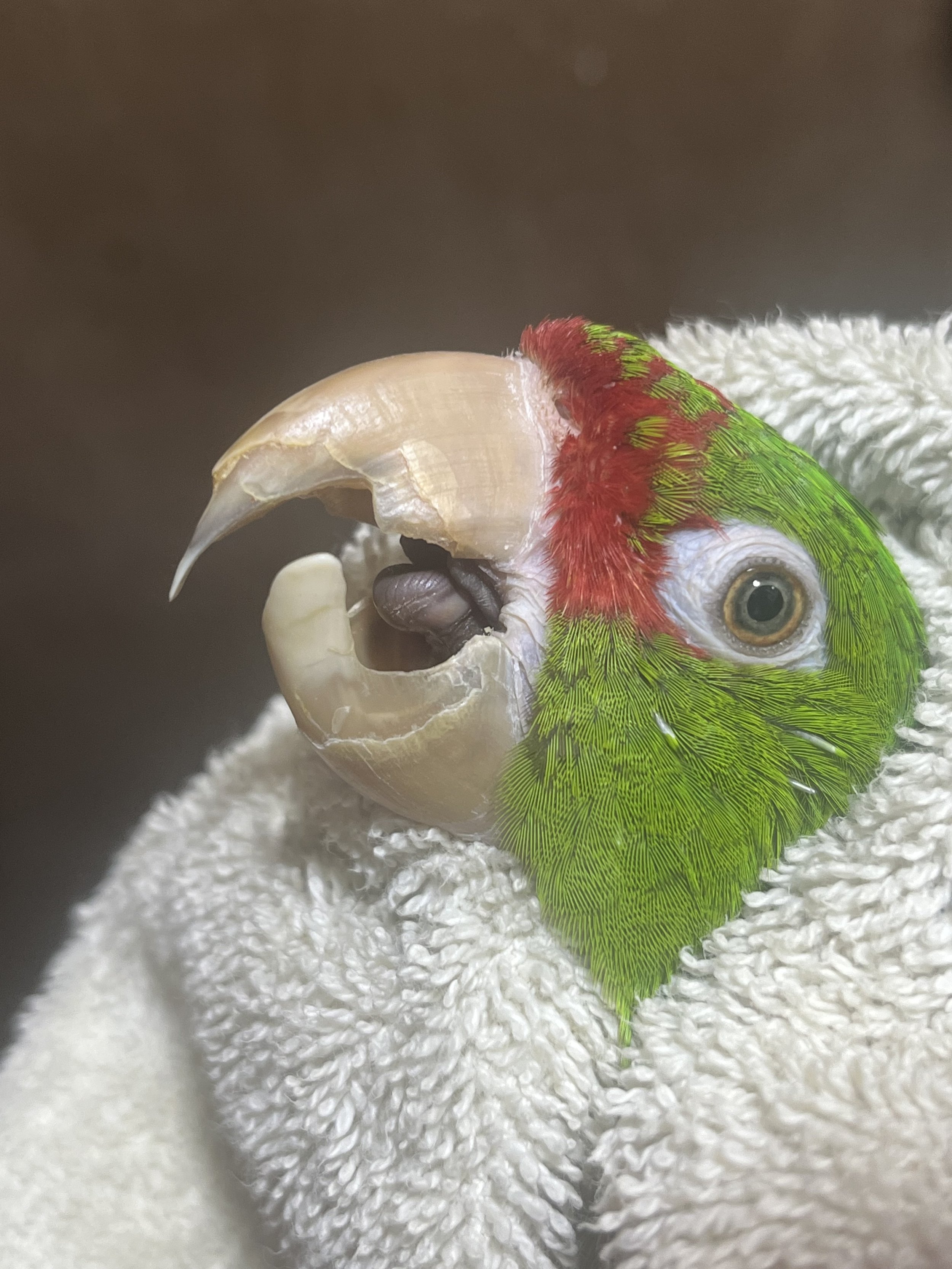
26 year old Mitred Conure Hybrid with scissor beak deformity
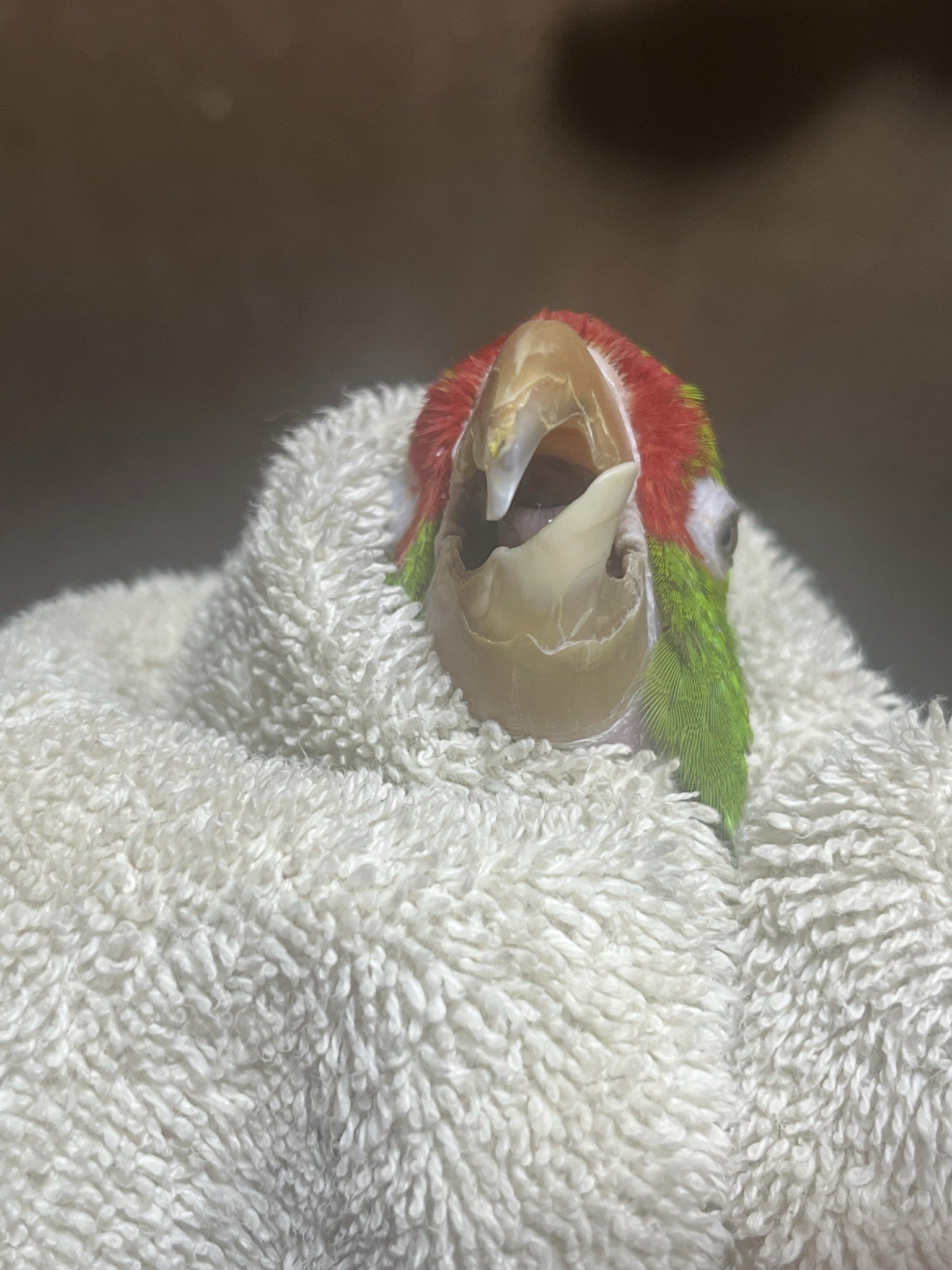
Lower beak grows quicky due to minimal use.

Shortened lower mandible spike and smoothed out flaking on upper mandible.
Topics coming soon:
Fatty Liver Disease, hypovitaminosis A, How to Make a First Aid Kit, Household Dangers, How to recognize illness










